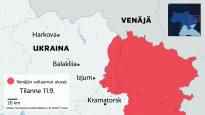In recent days, Russian military forces have been withdrawing at a high speed, especially in the direction of Kharkiv in Ukraine. The rapid change in the front lines indicates that the Russians have been caught by surprise.
– A controlled withdrawal would be slower. For example, retreat routes should be mined to slow down the attacker, says National Defense University strategy teacher, captain Antti Pihlajamaa.
– Now Ukraine’s rapid advance indicates that the Russian troops have been scattered in some places and the retreat has turned into a spontaneous escape, Pihlajamaa continues.
The same is said by those who closely follow the war in Ukraine Emil Kastehelmiwhich the work group led by updates the situation map published online.
The map is updated based on images uploaded to social media and satellite data, among other things.
– We started seeing material online where the Ukrainian flag had been pulled down even before the arrival of the Ukrainian troops. The Russians had left on their own initiative without a fight, Kastehelmi says.
The goal is to make maintenance more difficult
According to Captain Pihlajamaa, especially in the Kharkiv region, a significant regional turn has been seen in recent days, when Ukrainian forces have started to take over strategically important targets.
Ukraine says it has recaptured, among others, the cities of Balakliya, Izjum and Kupyansk.
– The city of Kupyansk is a logistically important destination, as the railways leading to eastern Ukraine pass through it. It is now even more difficult for Russia to maintain its troops, which makes it difficult to continue the attack in eastern Ukraine even more widely, says Pihlajamaa.
Strategy teacher Pihlajamaa believes that Russia did not expect an attack in the Kharkiv region. This is evidenced, among other things, by the fact that troops had been moved to strengthen the Kherson front.
According to Kastehelmi, who follows war maps, Ukraine’s attack began in an area that had previously seen little military activity.
– A small movement had been seen near Izjum, but the speed of the Ukrainian counterattack surprised me, Kastehelmi states.
A multi-front war is expensive
According to Pihilajamaa, Russia is now paying a high price for deciding to attack on several fronts in the spring.
– Now we should also be able to defend those same fronts, says the strategy teacher.
The arms aid given by the West has significantly consumed Russia’s military resources in the war that has lasted more than half a year.
– Russian equipment is now older and the crew less well trained than at the beginning of the war, Pihlajamaa estimates.
According to Pihilajamaa, however, it is not worth drawing too far-reaching conclusions about the course of the entire war from the rapid change in the front lines.
Information from the front is also very fragmented. Kastehelmi’s map work group collects material from both social and traditional media and compares, for example, the location information of photos.
– The aim is to use all the material to eventually create a valid snapshot on the map, but it is challenging, says Kastehelmi.
The front lines drawn on the map form a still image of the war, which does not tell what is happening in the occupied areas or how the next attacks will end.
In the end, the key is which side has more well-maintained and replenished forces and which one is able to use them at the right time in the right place, says Pihlajamaa, a teacher at the National Defense University.
As the war drags on, the growing lack of resources inevitably affects the way both sides fight.
– Now Russia knows that Ukraine is capable of a counterattack. This means that they now have to think even more about what they themselves are capable of and what is important to them in the war, summarizes Pihlajamaa.
Read more:
